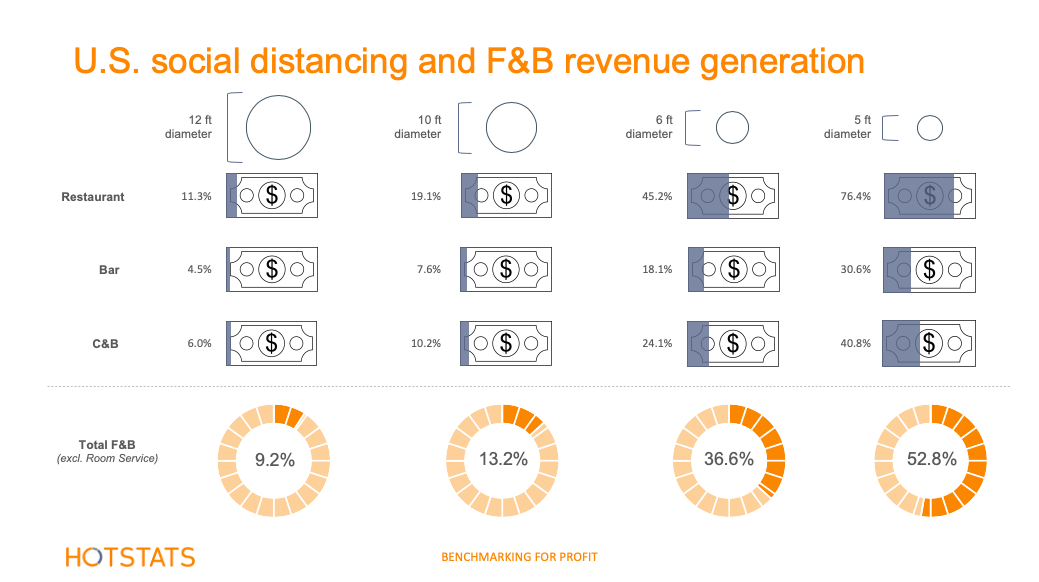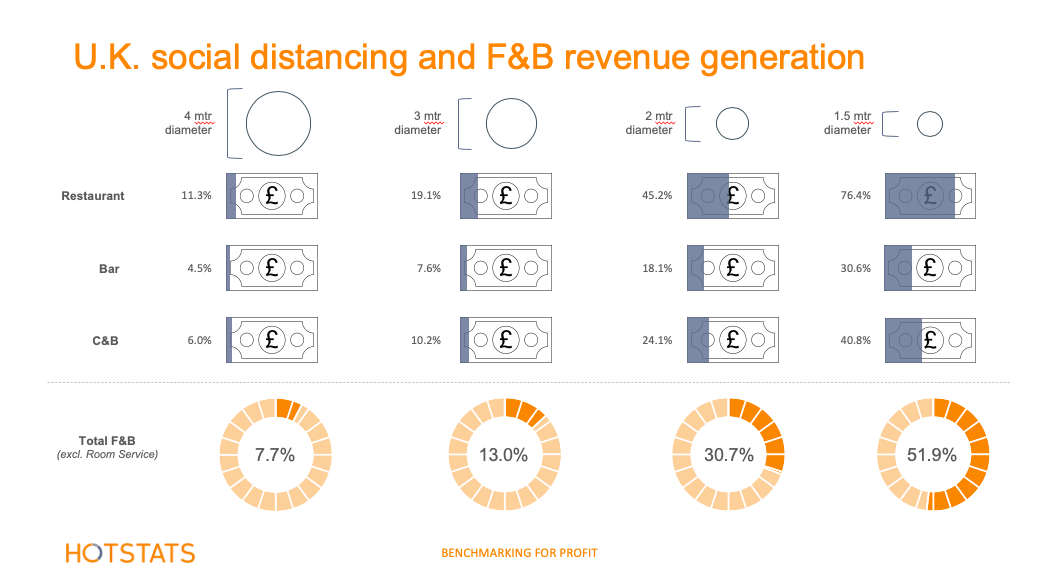
When 2020 is over and done with (could not come sooner, right?), “social distancing” will be the frontrunner for buzz term of the year. It doesn’t even matter that the World Health Organization has lobbied vigorously for the phrase to be dropped in favor of “physical distancing.”
Poppycock … hogwash … piffle … social distancing shall proceed as the preferred patois of the pandemic.
Social distancing will play a key role in hospitality operations going forward, and in no place will this be more pronounced than food and beverage operations (F&B), which include restaurants, bars and conference and banqueting.
F&B is a habitually slight profit margin operation. And that was before COVID-19 cozied up to the table. Now, hoteliers will be saddled with social distancing guidelines, which potentially mean fewer covers, fewer pours and less revenue.
The Centers for Disease Control and Prevention (CDC) has issued considerations for F&B operations amid the pandemic in order to protect guests and employees alike. They naturally err on the side of health and safety rather than revenue and profit.
The risk of COVID-19 spread increases in a restaurant or bar setting as follows, per the CDC:
- Lowest Risk: Food service limited to drive-through, delivery, takeout and curbside pickup.
- More Risk: Drive-through, delivery, takeout and curbside pickup emphasized. On-site dining limited to outdoor seating. Seating capacity reduced to allow tables to be spaced at least 6 feet apart.
- Even More Risk: On-site dining with both indoor and outdoor seating. Seating capacity reduced to allow tables to be spaced at least 6 feet apart.
- Highest Risk: On-site dining with both indoor and outdoor seating. Seating capacity not reduced and tables not spaced at least 6 feet apart.
Risk dovetailed with the course of the pandemic. There is no risk for hotels that closed down during the pandemic, but for those that remained open, risk is presumptively ubiquitous. However, proper precautions can ease the danger.
Hotels are now looking to get back to some semblance of normalcy. That means reopening F&B outlets and banquet rooms. How they open and what restrictions are put in place in terms of spatial positioning will be a deciding factor in revenue generation.
In order to make some sense of it, HotStats ran an analysis on the impact social distancing has on F&B revenue generation. Clearly, stricter compliance with CDC guidelines will likely lead to lower revenue but be safer. Meanwhile, paying less attention to guidelines could lead to better revenue, but a higher health risk.
A 6-foot distance between individuals is the current recommendation to reduce the transmission of COVID-19. One way of converting the CDC’s 6-foot separation criteria to occupant load is to calculate the area of a circle with a radius of 6 feet, which is equal to approximately 113 square feet per person. This represents a conservative approach that accounts for instances when people might be standing along a wall or might not be standing in the center of the circle.
Our model posits four scenarios from strict/conservative to lenient/liberal. The most conservative model uses the 6-foot radius (12-foot diameter or 113 square feet), followed by a 5-foot radius (10-foot diameter or 78 square feet), followed by a 3-foot radius (6-foot diameter or 28 square feet), followed by the most lenient model at a 2.5-foot radius (5-foot diameter or 19 square feet).
Based on this framework, we calculated the percentage of revenue capture compared to that of normalized times absent social-distancing rules.
The results are as striking as they are expected. (Note: We ran the same scenario for U.K. hotels and the results were the same except for total F&B generation.)
When using the 12-foot-diameter guidance, restaurants are only able to generate 11.3% of the 100% of total restaurant revenue generated pre-COVID, with no spatial restrictions; bars only 4.5% of total bar revenue; and conference and banqueting only 6.0% of total conference and banqueting revenue.
As the modeling loosens up, the returns improve. Using 10-foot-diameter guidance, restaurants are able to generate 19.1% of total restaurant revenue; bars 7.6% of total bar revenue; and conference and banqueting 10.2% of total conference and banqueting revenue.
On a 6-foot-diameter layout, restaurants are able to drive 45.2% of total restaurant revenue; bars 18.1% of total bar revenue; and conference and banqueting 24.1% of total conference and banqueting revenue.
The most lenient scenario, a 5-foot diameter, produces the highest percentages. Restaurants are able to generate 76.4% of total restaurant revenue; bars 30.6% of total bar revenue; and conference and banqueting 40.8% of total conference and banqueting revenue.
Lastly, we calculated total F&B revenue, exclusive of room service. It takes into consideration the sum of marginal contribution of each outlet. Typically, conference and banqueting generates the highest portion of total F&B revenue at 53% with restaurant and bar following at 36% and 10%, respectively.
In this scenario, under the strictest guidelines, only 9.2% of total F&B revenue (7.7% for the U.K.) is generated; under the most lenient guidelines, almost 53% of total F&B revenue 52% for the U.K) is generated. The upshot: Every dollar generated is reduced by almost 50 cents.
Like any study, there are limitations. The percentages calculated would be the max amount earned based on historical data, but the likelihood is they could be much lower because not as many people are currently dining out.
Per the CDC, guidelines, unlike some types of policies, are not mandatory. The social distancing guidelines set forth are not meant to enforce but rather to recommend programs or practices based on the best evidence available.
Every hotel is responsible for its own decisions as the world continues to grapple with the implications of COVID-19. Of course, the safety of patrons is paramount, but the ability to operate a successful and profitable F&B operation depends on the ability to serve guests.
Prior to the pandemic, a crowded dining room and standing-room only at the bar constituted a successful night. Now, those goals are seemingly unattainable in the near term.
Hoteliers are now forced to decide how best to run their F&B operation, or if running it at all makes sense. Based on these findings, it’s food for thought.


 Click to Enlarge Image
Click to Enlarge Image Click to Enlarge Image
Click to Enlarge Image